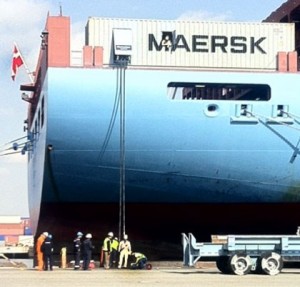The following is the text of a news release from Maersk Line:
(COPENHAGEN) — Air quality in California was the worst in the U.S., so California has taken many actions to reduce air pollution. The shore power rule requires emissions to be reduced by 50 percent in each port starting in 2014.
Strong environmental performance remains a priority area for Maersk Line’s sustainability efforts that are aimed at creating long-term value for our customers, our shareholders and the society. Keeping up with these efforts, Maersk Line ships have been installed with the solution called alternative marine power (AMP). Also known as "cold ironing," this solution enables the vessel on operate on electricity from the shore grid on the ports. What it means is that if you visit a Maersk vessel in port in California, you will see something unusual: the engines are not running. The vessel is operating on electricity so there are no emissions.
The alternative marine power solution consists of two extension cords lowered from the vessel and connected to a vault in the dock. The electricity is delivered at 6,600 volts, so safety has a very high priority and close cooperation between vessel and terminal is essential.
Alternative marine power (AMP) project
The project has equipped 16 vessels for shore power, at the cost of USD 1 million per vessel, plus the same or more for each berth. The biggest challenge was to design, install and commission each vessel before they called California ports in 2014.
It has been quite a project, requiring efforts from around the world. The core team involved the electrical support and project implementation teams under ship management, and North America Liner Operations Center. Installation involved vendors based in Denmark, Japan, Germany and Korea, and personnel from Global Stowage Planning, Maersk Line Limited, APM Terminals Los Angeles, and the vessel crews.
Project Manager Sukesh Daniel Paul explains, “There were many pieces of the puzzle to be put together in a short time. We installed the shore power equipment in 40-foot containers to allow future repositioning. We shipped the AMP containers and 10 tons of cables and materials across the world to each ship, and riding teams did the installation. When vessel schedules changed, materials and teams had to be redirected. We managed to complete the installation while the vessels were underway and without disrupting the normal vessel operation – timing was everything.”
Keeping the vessels on schedule
After eight months of working together, the team met in Los Angeles to commission the vessels. Commissioning involves close coordination with the terminal and port personnel to test the vessel and shore systems. Time is limited to keep the vessels on schedule. On June 26, Gudrun Maersk made the last commissioning call in Los Angeles.
Strong environmental performance
Using shore power for a large vessel for one day has the environmental impact of taking about 40,000 cars off the road, reducing health impacts for port communities.
Shore power is now a regular part of calling California. While the vessel modifications were expensive, early results show that shore power electricity actually costs less than the diesel fuel (marine gasoil) otherwise required in California, adding a financial benefit to the cleaner air which can now be enjoyed around the port.

